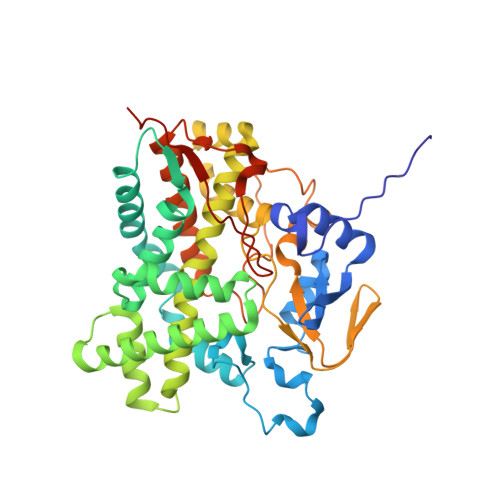A single mutation at the ferredoxin binding site of p450 vdh enables efficient biocatalytic production of 25-hydroxyvitamin d3.
Yasutake, Y., Nishioka, T., Imoto, N., Tamura, T.(2013) Chembiochem 14: 2284-2291
- PubMed: 24115473
- DOI: https://doi.org/10.1002/cbic.201300386
- Primary Citation of Related Structures:
3VRM - PubMed Abstract:
Vitamin D3 hydroxylase (Vdh) from Pseudonocardia autotrophica is a cytochrome P450 monooxygenase that catalyzes the two-step hydroxylation of vitamin D3 (VD3 ) to produce 25-hydroxyvitamin D3 (25(OH)VD3 ) and 1α,25-dihydroxyvitamin D3 (1α,25(OH)2 VD3 ). These hydroxylated forms of VD3 are useful as pharmaceuticals for the treatment of conditions associated with VD3 deficiency and VD3 metabolic disorder. Herein, we describe the creation of a highly active T107A mutant of Vdh by engineering the putative ferredoxin-binding site. Crystallographic and kinetic analyses indicate that the T107A mutation results in conformational change from an open to a closed state, thereby increasing the binding affinity with ferredoxin. We also report the efficient biocatalytic synthesis of 25(OH)VD3 , a promising intermediate for the synthesis of various hydroxylated VD3 derivatives, by using nisin-treated Rhodococcus erythropolis cells containing VdhT107A . The gene-expression cassette encoding Bacillus megaterium glucose dehydrogenase-IV was inserted into the R. erythropolis chromosome and expressed to avoid exhaustion of NADH in a cytoplasm during bioconversion. As a result, approximately 573 μg mL(-1) 25(OH)VD3 was successfully produced by a 2 h bioconversion.
- Bioproduction Research Institute, National Institute of Advanced Industrial Science and Technology (AIST), 2-17-2-1, Tsukisamu-higashi, Toyohira-ku, Sapporo 062-8517 (Japan).
Organizational Affiliation:


















